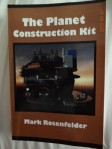 Title: A Dictionary of Made-Up Languages: from Adunaic to Elvish, Zaum to Klingon: the Anwa (Real) Origins of Invented Lexicons
Title: A Dictionary of Made-Up Languages: from Adunaic to Elvish, Zaum to Klingon: the Anwa (Real) Origins of Invented Lexicons
Author: Stephen D. Rogers
Publication Information: Avon, Mass.: Adams Media, c2011
ISBN: 1-4405-2817-9 (978-4405-2817-0)
Library of Congress Classification: P120.I53
Library of Congress Subject Headings:
Imaginary languages—Dictionaries
Artificial languages—Dictionaries
This book is just what it says it is: a dictionary of made-up languages. What this means is that there are dictionary entries in alphabetical order (usually a page, sometimes more) of made-up and artificial languages. Each entry has some or all of the following information: spoken by; documented by; behind the words (the background culture of the people/place the language is used); characteristics of the language; a taste of the language; numbering system; philological facts; if you’re interested in learning the language; for more information (usually a reference to the books mentioned in behind the words, web pages or to look at the general bibliography in the back of the book). There are two additional sections at the end called “Construct Your Own Language” and “Language Games.” The book has a one-page bibliography, an appendix of “Works, Languages Creators, and the Languages Associated with Them,” a glossary and an index.
I bought this book at the same time I bought Mark Rosenfeld’s The Planet Construction Kit and The Language Construction Kit. For someone who had NO idea any of these languages existed (more than in just a passing reference), this was an eye-opening book. I only knew Klingon as an artificially-created language since I’ve always been a Star Trek fan. Of course I knew of the languages created by J.R.R. Tolkien for his Lord of the Rings trilogy, having read all the books years ago. There’s entries for: Newspeak from George Orwell’s Nineteen Eighty-Four; Land of the Lost, the 1970s television series that I loved, has an entry for Pakuni, which was created by linguist Victoria Fromkin for the Pa’ku, the primitive humanoids that inhabited the land, Ch’ka being the most prominent member; Harry Potter‘s Parseltongue and Gobbledegook; Earth: Final Conflict‘s Eunoia, spoken by the Taelons; besides Klingon, Star Trek‘s Vulcan and Rihannsu, the language of the Romulans (based on Old Vulcan); Gulliver’s Travels‘ Houyhnhnm (the civilized horses); Stargate‘s Goa’uld; Ursula K. LeGuin’s Kesh, and so many more.
There’s also artificial languages created like Esperanto, which was created to be an international language. One critic on Amazon.com wondered why Tsolyani, created by Professor M.A.R. Barker for the role-playing game Empire of the Petal Throne and Novial, an artificial language created by linguist Otto Jespersen, weren’t included. Frankly, I think this is a great beginning in trying to document as many imaginary and artificial languages that exist. Second (and future) editions could only add these and other languages to the dictionary.
This is an excellent reference. I hope to see it updated in the future.


